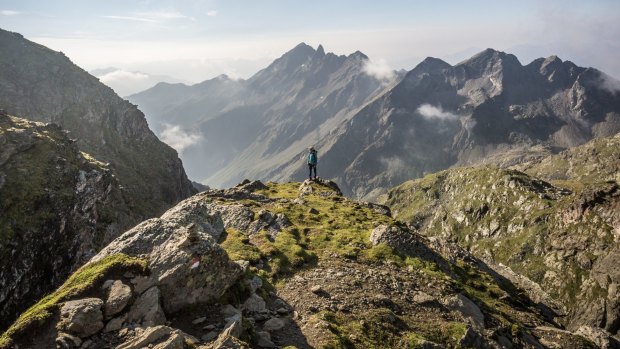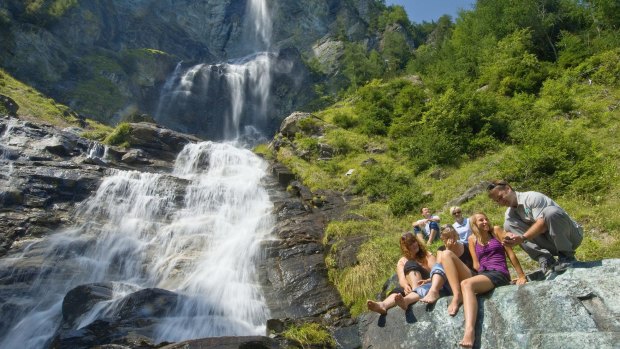This was published 1 year ago
Hohe Tauern National Park, Austria: Europe's biggest alpine national park is highly underrated
By Andrew Bain

Hohe Tauern is furnished with more than 300 summits above 3000 metres.Credit: Austrian National Tourist Office
For hikers, the European Alps are arguably the world's most civilised mountain range. Chairlifts run like zips up and down the slopes of major peaks, and restaurants and cafes dot meadows, passes and even summits.
It's a scene that spreads right across the range, including into a tiny valley in a quiet corner of one of the Alps' least celebrated countries: Austria.
On the banks of a stream through the Oberhauser Valley, we've begun hiking beside a restaurant, and are heading up-valley towards another. Cows lounge about as contentedly as cruise ship passengers, and marmots stand sentry above the meadows as though guarding the cows. Peaks rise like fins high above, and at the height of summer the valley is starred with constellations of flowers.

Austria deserves higher standing among the Alpine countries for its incredible beauty.Credit: Austrian National Tourist Office
"I think this is one of the most beautiful valleys I've ever walked in," says Hedonistic Hiking owner and guide Mick Parsons as he leads our group beside the stream.
The Oberhauser Valley is one tiny portion of one very large reason why Austria deserves higher standing among the Alpine countries. That reason is Hohe Tauern National Park, the largest national park in the Alps.
Hohe Tauern is furnished with more than 300 summits above 3000 metres, including Austria's highest mountain, Europe's highest waterfall and the Alps' largest crystals. And yet, for all that, it's a road that is the park's most famous feature.
To reach the Oberhauser Valley, we've crossed the Alps from the north on the Grossglockner High Alpine Road. Austria's highest sealed road, topping out at 2500 metres above sea level, Grossglockner is a classic mountain drive, squiggling through 36 hairpin bends as it makes its 48-kilometre journey across the shoulders of the mountains.
Built to employ the jobless in the early 1930s, the road took 3000 men more than three years to construct. At its northern end, it begins near the ski town of Zell am See, where it quickly squeezes into a narrow gorge that looks barely wide enough for the road.
Past the gorge, as the world opens wide again at the national park entrance, the road climbs quickly through a tangle of hairpin bends to its highest point, where peaks break through cloud and the road now below looks like the meanders of a river.
As the Alpine Road pushes across the mountains, a secondary road detours away to Grossglockner's star feature, Franz-Josefs-Hohe. This vast viewpoint is balanced above the longest glacier in the eastern Alps, with Austria's highest mountain, the 3798-metre Grossglockner, towering above.
The greatest surprise is not the gobsmacking Alpine scenery, but the presence of a multi-storey car park, which sits among a four-level national park visitor centre, a funicular railway down towards the glacier, and a Swarovski observation tower, all clipped to the rock walls above Pasterze Glacier.
The most daring construction here is Gamsgrubenweg, a hiking trail that burrows through the cliffs beyond Franz-Josefs-Hohe. Instead of walking over the mountains, I'm walking through them as I set out into a tunnel worthy of a railway.
Window slots provide fleeting views, but after two kilometres the tunnel ends and the gentle trail continues across the open slopes of what is arguably the centrepiece of the Austrian Alps.
Here the rock walls are scoured bare from a time when the Pasterze Glacier was far larger, and ibex graze the grassy slopes above the trail. Across the deep cleft carved by Pasterze, Grossglockner rises tall and sharp, like the nib of a pencil, with a multitude of smaller glaciers hanging from its hips.
From here, I'm effectively looking over the origins of the national park. In 1899, a local man named Albert Wirth visited Yellowstone National Park in the US, returning home with the idea of creating a similar park scheme in Austria.
In 1918, Wirth bought an area of land around Pasterze Glacier, gifting it to the Austrian Mountaineering Association on the condition it be preserved as a conservation area. It wasn't until 1981, however, that Austria's first national park was declared around it.
Back at Franz-Josefs-Hohe's visitor centre, it's approaching lunchtime, but the best eating is three kilometres back along the road at the tiny treasure of Glockner Sennerei Knapp Kasa.
Hidden below the road and barely signed, this family-owned stone hut serves up classically hearty Alpine fare - the poverty food of the mountains made good. Platters of house-made cheeses, salamis and bread precede speckknoedel in broth, with homemade schnapps to fire the belly for the coming afternoon.
If we've crossed the park by its busiest route – around one million people travel the Grossglockner High Alpine Road each year – we're now heading for one of its quieter reaches. On its southern side, the road dips into a glacially carved U-shaped valley, where waterfalls dive over high cliffs in scenes reminiscent of Switzerland's Lauterbrunnen Valley.
West of here, the Defereggen Valley marks one edge of the national park as it approaches the Italian border, and it's here that we begin hiking into the Oberhauser Valley the next day.
Common to international national parks, Hohe Tauern protects not just natural features but also cultural heritage, such as the high summer grazing lands of Jagdhausalm, a loose collection of stone shepherd houses that is our destination this day.
One of Austria's oldest and highest summer pasture villages, Jagdhausalm's only grazing function now is for hikers, with one of its stone huts transformed into a nameless mountain restaurant.
The valley is a classic snapshot of Alpine walking, its slopes matted with pine forest, the path lined with seats and the air ringing with cowbells.
It's a steady, but never steep, climb through the valley, with Jagdhausalm 500 metres higher than the trailhead. We cross winter avalanche paths as we meander beside the stream, which splits into two high up the valley. Once branch veers right into a deep glacial valley, while the left fork leads to Jagdhausalm.
With its stone buildings coloured like the bare mountains, Jagdhausalm looks like a Spanish village, except for the Austrian flag flying out front of its restaurant. In the glare of the Alpine sun, we lunch on nettle soup, meats and cheese cured right here, and slabs of house-churned butter almost as large as wheels of cheese. The 3000-metre-high peaks soar around us, and the Italian border is just two kilometres away.
On our next walk, the border will be even closer, for here at the park's edge there's a chance to hike into Italy – the rarity of an international crossing on a day walk.
We set out for the border from the small village of Mariahilf in the Defereggen Valley, climbing steeply up a ridge to join an old smugglers' route through a valley towards the border.
In the valley, the trail drops to a stream with a road running beside it, allowing our lunch stop to be the full gourmet affair. Guide Iole has transported in a table, homemade minestrone soup, bottles of wine and a spread of platters and berries, which we eat while lazing on the grassy bank of the stream.
I could easily lie here all afternoon staring at the mountains and sleeping off the wine, but Italy beckons less than five kilometres up the valley. We walk on, rounding the shores of Obersee and making one final climb to Staller Sattel, the 2052-metre pass where Austria tumbles away steeply into Italy.
I'm about to step out of the Alps' largest national park, but I'm no longer sure there's anything greater ahead of me in these mountains.
FIVE ALPINE NATIONAL PARKS
Swiss National Park
Switzerland's only national park, in the country's far east. Contains 21 marked hiking trails, with most graded as easy.
Berchtesgaden National Park
Tucked into a finger of land along Germany's southern border, this park covers the peaks and lakes of the Berchtesgaden Alps and has great hiking areas.
Mercantour National Park
A slender park along France's southern border with Italy, containing more than 600 kilometres of trails, including the long-distance GR5.
Gran Paradiso National Park
Italy's oldest national park encompasses the Gran Paradiso, the only mountain above 4000 metres entirely inside the country.
Triglav National Park
Near popular Lake Bled, Slovenia's only national park is framed around the country's highest peak, 2864-metre Triglav.
THE DETAILS
FLY
The nearest city to Hohe Tauern National Park is Innsbruck. Austrian Airlines flies daily to Innsbruck from Sydney and Melbourne. See austrian.com
HIKE
Hedonistic Hiking's nine-day Austria and the Dolomites trip includes four days in and around Hohe Tauern, with hikes ranging from 11 to 18 kilometres a day. The trip begins in Innsbruck and ends in Verona, and starts from $5250. See hedonistichiking.com
MORE
Andrew Bain travelled courtesy of Hedonistic Hiking.
Sign up for the Traveller Deals newsletter
Get exclusive travel deals delivered straight to your inbox. Sign up now.